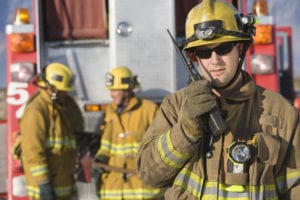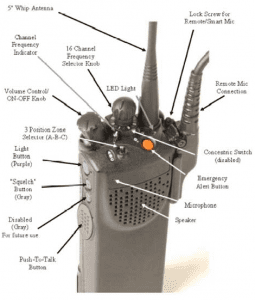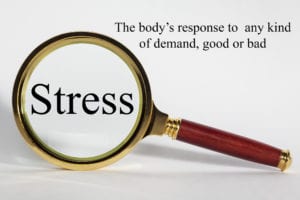I recently was contacted by a fire officer asking whether their mayday procedure should include a provision for a dedicated mayday channel for the distressed crew to transmit their post-mayday traffic on. This is a question I’ve been asked often enough that I want to dedicate an article to the topic of mayday communications procedures.
The mayday environment
 When training firefighters on mayday procedures you should create conditions that resemble the real-life environment they will face during a mayday event. However, it will be nearly impossible to evoke the kind of stress response a firefighter will experience when they are in fear for their life. The stress will be intense and under such conditions the brain will be in survival mode. Under these conditions the responder may struggle to remain composed. It may not be reasonable to expect the responder will remember to change the radio channel.
When training firefighters on mayday procedures you should create conditions that resemble the real-life environment they will face during a mayday event. However, it will be nearly impossible to evoke the kind of stress response a firefighter will experience when they are in fear for their life. The stress will be intense and under such conditions the brain will be in survival mode. Under these conditions the responder may struggle to remain composed. It may not be reasonable to expect the responder will remember to change the radio channel.
Why change channels
On the surface, it makes sense to give a distressed crew dedicated access to airtime. A distressed crew may not have time to wait to transmit critical messages. During a mayday it is likely the amount of radio communications is going to increase as command attempts to gather information and coordinate rescue efforts. Overwhelming the radio channel a distressed crew needs to communicate on does not seem prudent. The reasonable solution is to segregate the radio traffic of operational personnel from the distressed personnel.
How to segregate radio traffic
 Coordinating the change of radio channels in the middle of an incident can be extremely challenging. Inevitably, some personnel will hear the message to change channels and some will not. Some will change to the proper channel, some will not. You’re even at risk that the distressed personnel, in confusion, will change to the newly assigned operational channel. The entire concept of changing radio channels in a high-stress situation is fraught with challenge. The challenge can be made greater depending on the complexity of your radios.
Coordinating the change of radio channels in the middle of an incident can be extremely challenging. Inevitably, some personnel will hear the message to change channels and some will not. Some will change to the proper channel, some will not. You’re even at risk that the distressed personnel, in confusion, will change to the newly assigned operational channel. The entire concept of changing radio channels in a high-stress situation is fraught with challenge. The challenge can be made greater depending on the complexity of your radios.
Who should move?
If you decide to change radio channels, it is the non-distressed personnel who should change channels, not the distressed personnel. This is not to suggest the non-distressed personnel are not going to be feeling stress. They will be. One or more of their comrades are in peril. That is going to be stressful. Stress notwithstanding, the non-mayday personnel are in the better position to make the change.
Procedure – Training – Practice
If you’re going to expect personnel to change channels during a mayday event, it must be set-up properly. This includes the development of a coherent mayday procedure that stipulates when and how radio channels are to change. Then, personnel need to be trained on when and how to change channels. Finally, personnel need to practice changing radio channels under conditions similar to a mayday environment. I cannot stress enough how important it is to ensure the training and practice is realistic and repetitive.
Watch for human behavior traits
 As you put personnel under stress, you will witness human behavior traits that will be displayed during real incidents. Attempting to fix these nuances with policies is going to prove frustrating, if not catastrophic. Rather, watch how people behave and make sure the policies and training support expected human behavior. Otherwise, you’re at risk of having policies that people will not… cannot comply with. They won’t be doing it on purpose. But the behavior will, nonetheless, be predictable.
As you put personnel under stress, you will witness human behavior traits that will be displayed during real incidents. Attempting to fix these nuances with policies is going to prove frustrating, if not catastrophic. Rather, watch how people behave and make sure the policies and training support expected human behavior. Otherwise, you’re at risk of having policies that people will not… cannot comply with. They won’t be doing it on purpose. But the behavior will, nonetheless, be predictable.
Rich Gasaway’s Advice
 The best way to prepare for a mayday incident is to develop a sound procedure, train personnel on the procedure and practice in realistic and repetitive ways. If those procedures involve changing radio channels, personnel need to practice this maneuver in the toughest of conditions. If, during your practice, it doesn’t work, consider changing the procedure or intensifying the practice.
The best way to prepare for a mayday incident is to develop a sound procedure, train personnel on the procedure and practice in realistic and repetitive ways. If those procedures involve changing radio channels, personnel need to practice this maneuver in the toughest of conditions. If, during your practice, it doesn’t work, consider changing the procedure or intensifying the practice.
Once you get your procedure set and personnel become good at it, the practice must then become part of on-going training for personnel. Muscles learn from muscle memory and the muscle memory needs to be refreshed periodically. This applies whether you’re doing hose lays, ladder throws or changing radio channels.
Strive to keep radio traffic short and simple.
Action Items
 1. Discuss how radio communications should be managed during a mayday event.
1. Discuss how radio communications should be managed during a mayday event.
2. Develop and implement a mayday communications management procedure.
3. Train personnel on the procedure.
4. Practice the procedure in realistic and repetitive ways.
5. Adjust the procedure if it’s not working as expected.
6. Repeat steps 3-5 until you find a procedure that works in a high stress environment.
_____________________________________________________

If you are interested in taking your understanding of situational awareness and high-risk decision making to a higher level, check out the Situational Awareness Matters Online Academy.
CLICK HERE for details, enrollment options and pricing.
__________________________________
Share your comments on this article in the “Leave a Reply” box below. If you want to send me incident pictures, videos or have an idea you’d like me to research and write about, contact me. I really enjoy getting feedback and supportive messages from fellow first responders. It gives me the energy to work harder for you.
Thanks,

Email: Support@RichGasaway.com
Phone: 612-548-4424
SAMatters Online Academy
Facebook Fan Page: www.facebook.com/SAMatters
Twitter: @SAMatters
LinkedIn: Rich Gasaway
YouTube: SAMattersTV
iTunes: SAMatters Radio

Chief, I agree whatever procedure is utilized it must be trained until its “muscle memory”. I also agree that the non-distressed personnel should be the only ones that do change channels. Regardless its probably going to be problematic.
That is what it is so critical that when the companies train they include the fire dispatcher! the dispatchers must be trained to monitor ALL potential frequencies for a call for help that the IC misses. The dispatcher must also be prepared to obtain the LUNAR and relay it to the IC. If a may day firefighter calls on the wrong frequency the dispatcher can’t tell them they are on the wrong channel and need to change. The dispatcher must take the LUNAR information and give it to the IC. The dispatcher must be equally prepared in these situations!
P.J.,
These are great points and with that you have inspired me to write an article about the role of dispatchers in situational awareness. Will be coming soon!
Thank you for sharing.
Rich
I eagerly await an article the role of dispatchers! It is a subject I have been quite vocal about, yet to some higher ups it sadly falls on deaf ears. ironic, I know.
So glad you addressed this topic, it’s got to be a somewhat touchy subject in all departments, but so necessary.
One thing to add is training with mutual aid partners as well. My colleague Jim Murphy (@Murph289) always mentions the surprise they got in his department doing mayday drills with a mutual aid partner (with whom they ran 6 or more calls with every day). It turned out the departments had exactly the opposite SOP in place for maydays regarding who was to switch channels, so they changed their SOP’s to be consistent. Luckily this one got discovered in training exercises!
Jonathan,
This is a great example of getting our collective acts together before being confronted with a Mayday situation. Thank you so much for sharing and for all you’re doing to improve firefighter safety!
Rich
Chief,
Great article. We conducted training both switching channels and staying on the same one. Our battalions where more comfortable keeping everyone on the same channel. We found that the some firefighters would jump channels back and forth to check “progress” on the situation. This could lead to missed communication on the other talk group. We decided to work with all companies on maintaining radio discipline. Mayday obviously is the priority and training is a must. Regardless of what policy that one organization has it must be trained on. Over the years we have spent countless hours teaching personnel how to get out of situations but have failed to push the point home about how not to get into those situations. As you say Situational Awareness is key.
Rob,
Great lesson! Thank you for sharing. I hope everyone reads your input.
Rich
Chief,
Thanks for posting this article. I do like the comments that P.J. posted about the dispatchers. He makes a great point. Unfortunately, that process only works for those departments that have their own dispatching. We have a county wide system and the capability of the dispatcher being able to monitor our fire ground operations is impossible because we switch to TAC channels at the beginning of the incident. For this reason, training is paramount to the success of any operation, as it is the officer staff that is handling the information. l agree that it is the non-distressed personnel that need to move channels and once again training is paramount to practice their own self discipline to follow orders and not switch between the channels. However, I will say that there is understanding why they have the urge. I have looked at a few programs out their regarding mayday reports. It is my opinion that the LUNAR report is the preferred method because it follows the keep it simple stupid method. I have taken the Fireground Safety and Survival Program sponsored by the IAFF and I like the concept. The only disagreement is that in intense situations, some objectives may be left out. Once again, training would be paramount. Thank you for sharing.
Ted,
I think the process can work when the dispatch is not provided by the department, so long as the dispatch center sees themselves as a provider of service and the agencies they serve as customers. Sadly, we both know this is not the case in many jurisdictions.
As for elements of LUNAR being left out during intense situations, this can certainly happen. One one to help reduce the possibility is to replicate (with safety in mind) intense situations and then practice LUNAR under those conditions. If LUNAR is rehearsed under non-stressful conditions, it is almost certain not to work when in the heat of battle.
Thanks for sharing!
Rich
Pingback: Situational Awareness Matters!™: The Mayday Channel | Smooth Bore Tip
We discussed this years ago when the 800 Mhz radios came onto the scene. Our conclusion is/was the radios should automatically “jump” to a dedicated emergency band whenever the emergency button is activated. The channel would be constantly monitored as set forth in SOP’s (alarm room, BC’s aide, communications, etc) Motorola told us it was possible. Never happened.